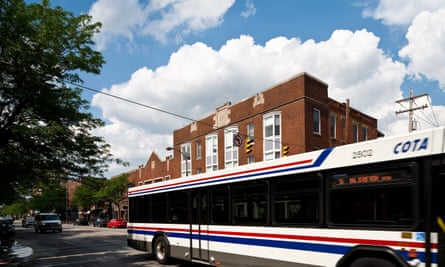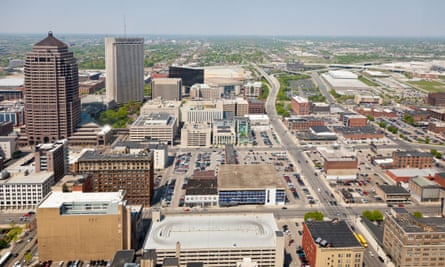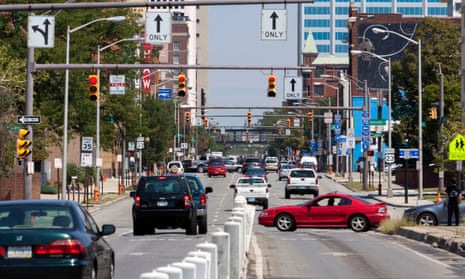One of the problems faced by the US city of Columbus is simple to articulate but hard to fix. Parking pressures in the centre are forcing businesses further out, and the question for downtown businesses is how to get people out of cars and on to public transport.
With a population of 860,090, Ohio’s state capital is now the 14th largest city in the country and after Chicago, the second-biggest in the midwest. It has grown by 28% (from 668,808) since 1997, and it is easy to see why; Columbus has a large university population, a growing arts scene, old money foundations spreading wealth and attractive older neighbourhoods in the centre.
But its transit problems are evident. The freeways into the city are packed at rush hour, and the downtown business district faces a car parking crunch, with few and expensive spaces for the 45,000 workers.
In other cities reducing the availability of car parking has been effective in getting more people to use public transport, but in Columbus it has prompted businesses to expand to suburban areas, where rent is cheaper and there is plenty of parking. Out of 84,00 employees in the downtown district, just 6% commute using public transport.
“We saw the vacancy rate growing downtown, and a large part of that was because parking spaces were becoming too expensive for the businesses and their workers,” says Cleve Ricksecker, executive director of Capital Crossroads Special Improvement District (SID), a private group working to improve downtown Columbus. “But it was the lower-paid service workers in the hotel and restaurant industry who were paying more than $1,500 a year on parking.
“Commuting to downtown was becoming financially stressful in Columbus. So we needed a solution that would be quick and simple.”

SID convinced its members – 500-odd business and property owners – to pay for free mass transit passes for their employees. Under the scheme, which was approved last month, the members will be charged an annual rate of three cents per square foot of space they occupy downtown. The fees will go to the Central Ohio Transit Authority (Cota) for their workers’ passes.
The passes can be used on any day and on any journey – not just the commute. The programme is limited to people who work downtown, turning a financial burden into an incentive.
“I think what the downtown pass programme is saying is that Columbus doesn’t really have a parking problem, it has a transit shortage,” says Mike Tomko, a real estate developer. “You can’t have 90 cars needing parking for every 100 people working downtown.”
Most US cities (apart from New York, Chicago and Los Angeles, the biggest cities) face one of two problems when it comes to getting people out of their cars and on to buses and trains.
The first problem is found in cities that peaked in the first half of the 20th century and planned their transit network before cars took over – Cleveland, Pittsburgh and St Louis, for example. They have narrow urban streets and compact downtown areas and neighbourhoods. But many are declining in population, and the challenge is how to maintain a mass transit system with fewer people and less money.

The second issue is prominent for fast-growing cities such as Dallas, Phoenix and Orlando that expanded with cars in mind in the second half of the 20th century. They have eight-lane freeways with little mass transit and large population growth. These cities have to figure out how to grow their public transport options at a time when any suggestion of public tax increases is often pilloried by conservative politicians and unpopular with voters.
What makes the programme in Columbus different from other mass transit funding in the US is the way it is applied. Many cities offer discounted passes, either through deals negotiated by the mass transit agency with individual companies or for lower-income riders such as students or pensioners.
Atlanta offers a 20% discount in monthly transit passes to downtown companies ($76 a month instead of $95). Seattle also has an individual employer-based discount, with the business and employee often splitting the cost. Boulder, Colorado has a similar programme called EcoPass for neighbourhood groups or employers buying passes for their residents or workers. Salt Lake City and Seattle have also experimented with subsidies, but they are often tied to increases in parking rates.
Cities around the world have approached free public transport in different ways. Tallinn, the capital of Estonia, has offered city-wide free mass transit since 2013, paid for by an income tax assessment on residents. In Wales, bus travel on the extensive TrawsCymru network is now free on weekends. Many countries have ticket options for certain riders, such as free off-peak public transport for pensioners in New Zealand and free use for students in the Netherlands.
But in the US, there has never been much of a push to expand mass transit use given its car-centric society. Columbus is the first major US city to give downtown workers free public transport passes regardless of where they work, and whether they intend to use them.
“The initial knee-jerk reaction by the business owners was definitely negative,” says Daniel Dunsmoor, senior vice president at Colliers International, a real estate company. “But we also knew that any of us who were in the business of leasing space to fill up buildings were also naturally in the parking business. And [that] was a problem that was adding to the vacancy rate.”
One way Ricksecker sold the idea was pointing to a successful transit programme at Ohio State, the third-largest university in the US located just outside the Columbus downtown area. The school charges its 60,000 students a small fee for access to campus buses.
“We sort of stole the idea from Ohio State because we found that more people use mass transit if you make it simple and available,” says Ricksecker. “People want to save money, and they use mass transit more as they get used to it. [This programme] won’t be as sexy as a billion-dollar rail line, but the pass system is simpler and we think it will be more successful.”
With the first two-year trial of the programme set to begin next summer, Ricksecker hopes that participation rate on public transport will triple to 20% in the years to come.
Kyle Ezell, a professor at Ohio State University specialising in urban planning, thinks the programme will be popular because of the potential savings it offers. “Transportation costs are higher for consumers than entertainment, food or healthcare costs,” he says.

“If you can cut a few thousand dollars off transportation, and people can then use that money to go to movies or restaurants, they will see that spending a half-hour on a bus and looking at their phone while commuting to work will be a good thing to do.”
The downtown pass programme will cost about $5m total – a figure that dwindles in comparison to Cota’s plans to invest nearly $8bn over the next 30 years on more urban circulator buses, non-stop freeway commuting routes, and potentially new rail lines to keep up with population growth.
Geri Lombard, manager of the 149-room boutique Hotel LeVeque in downtown Columbus, says it is “forward thinking” for the city in general. “We are in the business where training and keeping quality employees is of the utmost importance,” she says. “Great urban cities see that making the commute to downtown businesses easier and cheaper for employees is a key to the city’s success.”
If the programme is successful in getting more people to use public transport and is extended beyond two years, Ricksecker predicts it will have far-reaching benefits across Columbus. Older, nearby neighbourhoods could see an uptick in house prices, with the selling point as their 15-minute – and free – bus ride to work. The downtown entertainment and hospitality sectors could experience growth and be able to retain talented employees because of the non-existent costs of commuting.
“The reason I think this programme will have long-lasting value is that it is not connected with power brokers – this is a very broad, grassroots programme,” says Ricksecker. “We aren’t getting involved in something that might raise parking rates for downtown residents. We just wanted to find a way to keep good workers and businesses downtown, and we figure the easiest way to do that is to get them to work and back cheaper, and more efficiently. Pretty simple.”
Follow Guardian Cities on Twitter and Facebook to join the discussion, and explore our archive here

Comments (…)
Sign in or create your Guardian account to join the discussion